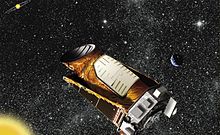William J. Borucki
William J. Borucki (* 1939 ) is an American space researcher who works at the NASA Ames Research Center . He began his scientific career in 1962 with the development of the heat shield for the spaceship of the Apollo program . His later research focus was on researching the optical efficiency of lightning in the atmosphere and their potential for the formation of organic molecules from inorganic molecules ( abiogenesis ). Borucki also deals with extrasolar planets and their discovery, especially with the help of the transit method . In the course of this, Borucki was chosen as the scientific project manager of the NASA Kepler mission . This mission started on March 6th, 2009 and aimed to find potentially habitable extrasolar planets. Borucki has received numerous awards for his accomplishments on the Kepler Mission.
Education and career

William Borucki graduated from the University of Wisconsin – Madison with a degree in physics in 1962 . He then started developing the heat shield for the Apollo program to protect the spaceship and its occupants from the heat generated when they re-entered the atmosphere. After the successful moon landing , he began developing photochemical models of the earth's atmosphere and stratosphere in 1972 to determine the effects of nitrogen monoxide and PFC emissions on the earth's ozone layer . After working for the Apollo program, Borucki studied meteorology at San José State University . After completing his meteorology studies in 1982, he began his research work at NASA on the role of lightning in the formation of abiogenic molecules in the atmosphere. He also participated in researching the frequency and distribution of lightning on other planets.
From 1984 Borucki focused on the observation of extrasolar earth-sized planets using the transit method . These observations included the periodic darkening of a star caused by the passage of a planet past a star in its orbit. In the same year and in 1987, Borucki organized scientific workshops with the aim of advancing method development for transit-based exoplanet detection. Together with the National Institute of Standards and Technology , photometers with sufficient sensitivity were developed. At the Lick Observatory , Borucki presented the methods that were necessary to determine extrasolar planets using the transmit method. To this end, he submitted a proof of concept for a ground-powered telescope .
In 2009, Borucki was selected by NASA as scientific project manager for the Kepler mission . This space telescope was intended to determine the frequency of earth-sized planets in the habitable zone around stars similar to the sun . As of January 2014, 242 such planets were discovered. Borucki has received numerous awards for his accomplishments, including the NASA Systems Engineering Excellence Award in 2010, the Lancelot M. Berkeley Prize in 2011, the George W. Goddard Award in 2012 and, finally, the prestigious Henry Draper Medal in 2013 . The latter award was justified as follows:
"For his founding concept, unflagging advocacy, and visionary leadership during the development of NASA's Kepler mission, which has uncovered myriad planets and solar systems with unforeseen and surprising properties."
"For his founding thought, undaunted advocacy and visionary guidance during NASA's Kepler mission, which discovered a multitude of planets and solar systems with unforeseen and surprising properties."
In June 2013, William Borucki celebrated his 50th anniversary since joining NASA. In 2015 he received the Shaw Prize for Astronomy. For 2016 he was awarded the Bower Award and Prize for Achievement in Science . In the same year he became a Fellow of the American Association for the Advancement of Science . In 2017 he was elected to the American Academy of Arts and Sciences and in 2020 to the National Academy of Sciences .
Publications
- J. Blomme, J. Debosscher, J. De Ridder, C. Aerts, RL Gilliland, J. Christensen-Dalsgaard, H. Kjeldsen, TM Brown, WJ Borucki, D. Koch et al .: Automated classification of variable stars in the asteroseismology program of the kepler space mission. In: Astrophysical Journal Letters . Volume 713, 2010, pp. L204-L207. doi: 10.1088 / 2041-8205 / 713/2 / L204
- WJ Borucki, D. Koch, G. Basri, N. Batalha, T. Brown, D. Caldwell, J. Caldwell, J. Christensen-Dalsgaard, WD Cochran, E. Devore and others: Kepler planet-detection mission: Introduction and first results. In: Science. Volume 327, 2010, pp. 977-980. doi: 10.1126 / science.1185402
- WJ Borucki, DG Koch, G. Basri, N. Batalha, TM Brown, ST Bryson, D. Caldwell, J. Christensen-Dalsgaard, WD Cochran, E. DeVore et al: Characteristics of planetary candidates observed by Kepler. II. Analysis of the first four months of data. In: Astrophysical Journal. Volume 736, No. 1, 2011. doi: 10.1088 / 0004-637X / 736/1/19
- WJ Chaplin, H. Kjeldsen, TR Bedding, J. Christensen-Dalsgaard, RL Gilliland, SD Kawaler, T. Appourchaux, Y. Elsworth, RA García, G. Houdek et al .: Predicting the detectability of oscillations in solar-type stars observed by Kepler. In: Astrophysical Journal. Volume 732, No. 1, 2011. doi: 10.1088 / 0004-637X / 732/1/54
- LR Doyle, JA Carter, DC Fabrycky, RW Slawson, SB Howell, JN Winn, JA Orosz, A. Přsa, WF Welsh, SN Quinn and others: Kepler-16: A transiting circumbinary planet. In: Science. Volume 333, 2011, pp. 1602-1606. doi: 10.1126 / science.1210923
- M. Fulchignoni, F. Ferri, F. Angrilli, AJ Ball, A. Bar-Nun, MA Barucci, C. Bettanini, G. Bianchini, W. Borucki, G. Colombatti and others: In situ measurements of the physical characteristics of Titan's environment. In: Nature. Volume 438, 2005, pp. 785-791. doi: 10.1038 / nature04314
- RL Gilliland, TM Brown, J. Christensen-Dalsgaard, H. Kjeldsen, C. Aerts, T. Appourchaux, S. Basu, TR Bedding, WJ Chaplin, MS Cunha et al: Kepler asteroseismology program: Introduction and first results. In: Publications of the Astronomical Society of the Pacific. Volume 122, 2010, pp. 131-143. doi: 10.1086 / 650399
- S. Hekker, J. Debosscher, D. Huber, MG Hidas, J. De Ridder, C. Aerts, D. Stello, TR Bedding, RL Gilliland, J. Christensen-Dalsgaard and others: Discovery of a red giant with solar-like oscillations in an eclipsing binary system from kepler space-based photometry. In: Astrophysical Journal Letters. 713, 2010, pp. L187-L191. doi: 10.1088 / 2041-8205 / 713/2 / L187
- MJ Holman, DC Fabrycky, D. Ragozzine, EB Ford, JH Steffen, WF Welsh, JJ Lissauer, DW Latham, GW Marcy, LM Walkowicz and others: Kepler-9: A system of multiple planets transiting a sun-like star, confirmed by timing variations. In: Science. Volume 330, 2010, pp. 51-54. doi: 10.1126 / science.1195778
- JM Jenkins, DA Caldwell, H. Chandrasekaran, JD Twicken, ST Bryson, EV Quintana, BD Clarke, J. Li, C. Allen, P. Tenenbaum and others: Initial characteristics of kepler long cadence data for detecting transiting planets. In: Astrophysical Journal Letters. Volume 713, 2010, pp. L120-L125. doi: 10.1088 / 2041-8205 / 713/2 / L120
- D. Koch, W. Borucki, L. Webster, E. Dunham, J. Jenkins, J. Marriott, H. Reitsema: Kepler: A space mission to detect earth-class exoplanets. 1998, pp. 599-607. doi: 10.1117 / 12.324482
- DG Koch, WJ Borucki, G. Basri, NM Batalha, TM Brown, D. Caldwell, J. Christensen-Dalsgaard, WD Cochran, E. Devore, EW Dunham et al: Kepler mission design, realized photometric performance, and early science. In: Astrophysical Journal Letters. 713, 2010, pp. L79-L86. doi: 10.1088 / 2041-8205 / 713/2 / L79
- JJ Lissauer, DC Fabrycky, EB Ford, WJ Borucki, F. Fressin, GW Marcy, JA Orosz, JF Rowe, G. Torres, WF Welsh and others: A closely packed system of low-mass, low-density planets transiting Kepler-11 . In: Nature. Volume 470, 2011, pp. 53-58. doi: 10.1038 / nature09760
Web links
Individual evidence
- ^ Kepler: William Borucki. In: Kepler: A Search for Habitable Planets. National Aeronautics and Space Administration, December 31, 2009; accessed January 28, 2014 .
- ^ A b c Jonas Dino: William J. Borucki. National Aeronautics and Space Administration, March 29, 2008; accessed January 28, 2014 .
- ↑ Alexander Van Dijk: The Transit Method of Detecting Extrasolar Planets. National Aeronautics and Space Administration, November 12, 2008, accessed January 28, 2014 .
- ^ Kepler: A Search for Habitable Planets. National Aeronautics and Space Administration, January 9, 2013, accessed January 28, 2014 .
- ^ William J. Borucki, Kepler Mission, Principal Investigator, NASA Ames Research Center. The World Technology Network, accessed January 28, 2014 .
- ↑ Maureen Moore: 2010 Systems Engineering Excellence Award. National Aeronautics and Space Administration, March 10, 2010, accessed January 28, 2014 .
- ^ Kepler Mission Leaders to Receive Inaugural Lancelot Berkeley Prize. National Aeronautics and Space Administration, July 28, 2013, accessed January 28, 2014 .
- ^ Stacey Crockett: Borucki honored with George W. Goddard Award. (PDF) Society for Optics and Photonics, July 28, 2013, accessed January 28, 2014 .
- ^ Henry Draper Medal. National Academy of Sciences , accessed January 13, 2016 .
- ↑ Michele Johnson: NASA Kepler Scientist Honored by the National Academy of Sciences. National Aeronautics and Space Administration, January 7, 2013, accessed January 28, 2014 .
- ^ Shaw Prize 2015 for Astronomy
- ^ Fellows of the AAAS: William Borucki. American Association for the Advancement of Science, accessed February 15, 2018 .
- ↑ Book of Members 1780 – present, Chapter B. (PDF; 1.2 MB) In: American Academy of Arts and Sciences (amacad.org). Retrieved December 27, 2017 (English).
| personal data | |
|---|---|
| SURNAME | Borucki, William J. |
| BRIEF DESCRIPTION | American space explorer |
| DATE OF BIRTH | 1939 |
